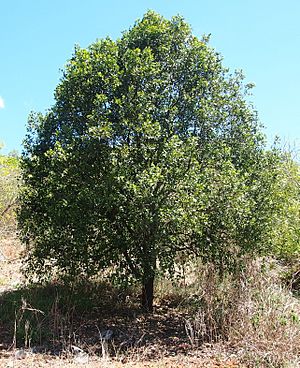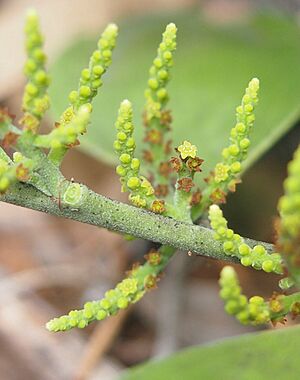Exocarpos latifolius facts for kids
Quick facts for kids Exocarpos latifolius |
|
|---|---|
 |
|
| Scientific classification | |
| Genus: |
Exocarpos
|
| Species: |
latifolius
|
 |
|
| Occurrence data from Australasian Virtual Herbarium | |
The Exocarpos latifolius is a special kind of tree. It's also known by many fun names like broad-leaved cherry or native cherry. This tree is a bit unique because it's a "parasitic plant." This means it gets some of its food from other plants, usually through their roots. You can find this interesting tree growing in warm, wet forests, especially in places like Northern Australia and parts of Malesia.
Contents
Discovering the Broad-Leaved Cherry Tree
The broad-leaved cherry tree is usually a small tree or a large bush. It can grow up to 10 meters (about 33 feet) tall. Its leaves are almost as wide as they are long, usually around 4 centimeters (about 1.5 inches).
Flowers and Fruit
This tree produces small flowers on thin stalks, usually about 1 centimeter long. The fruit is a round nut that sits on a short stalk. As the fruit ripens, this stalk swells up and turns bright red. It looks a bit like an inside-out cherry!
The actual nut-like fruit is small, about 4–6 millimeters long. While the nut itself is not good to eat, the swollen red stalk is edible. It was an important food source for Aboriginal Australians for a very long time. The name "exocarpus" comes from Latin words meaning "outer fruit," because the seed is on the outside of the edible part.
Where Does It Grow?
You can find the broad-leaved cherry tree in different types of forests. It often grows in "monsoon forests" and "littoral rainforests." These are special kinds of forests found in tropical areas, often near the coast. Sometimes, it also grows in more open forest areas across Northern Australia and in the region called Malesia.
Traditional Uses by Aboriginal Australians
The broad-leaved cherry tree was very important to Aboriginal Australians. They used different parts of the tree for many purposes.
Food and Medicine
The red, swollen stalk of the fruit was a traditional food. It provided a sweet snack from nature. Besides food, the leaves of the tree were also used. People would burn the leaves to create smoke that helped keep insects away. They also made a special liquid from the leaves to help treat sores.
Other Uses
The wood of the broad-leaved cherry tree is very fine and has interesting color changes. Because of its unique look, it was sometimes used to make furniture in the past. An old book from 1889, called 'The Useful Native Plants of Australia,' mentions that Aboriginal people in Queensland called this tree "Oringorin." It also noted the common names "Broad-leaved Native Cherry" and "Scrub Sandalwood."



